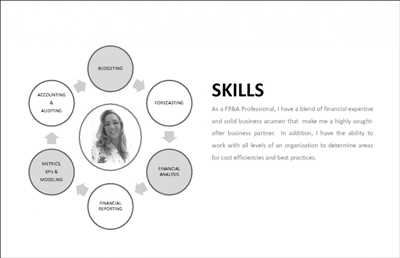
When it comes to showcasing your skills and highlighting your work, a comprehensive work portfolio is a must-have. Whether you are a developer, a designer, a writer, or any other creative professional, having a portfolio website is essential for getting your work seen by the right people.
But how do you create a work portfolio that not only impresses potential clients or employers, but also represents you and your work in the best possible way? In this post, we will guide you through the process of making a work portfolio from start to finish, covering everything you need to know.
The first thing you need to do when creating a work portfolio is to choose a domain name and set up your website. There are many options available to you, from free platforms to self-hosted options. Whatever you choose, make sure it is easy to navigate and showcases your work effectively.
Once your website is up and running, it’s time to start adding your work. When selecting which projects to include in your portfolio, make sure to choose a variety that showcases your skills and capabilities. It’s important to provide comprehensive information about each project, including the client, your role, and the tools and technologies you used.
When it comes to making your work portfolio stand out, the little details can make a big difference. One important thing to consider is the order in which you present your projects. Start with your best work or the projects that are most relevant to the type of work you want to do. You should also provide a brief description of each project, highlighting your role and any challenges or successes you encountered.
In addition to showcasing your work, your portfolio should also include a section about you. This can be a short bio, a list of your skills and experience, or even a personal statement. This will give potential clients or employers an idea of who you are and what makes you unique.
Finally, don’t forget to include your contact information and links to your social media profiles. This will make it easy for people to get in touch with you and stay connected. You may also want to consider adding testimonials from satisfied clients or colleagues, as this can help build trust and credibility.
Creating a work portfolio may seem like a daunting task, but with the right guidance and a little bit of inspiration, anyone can do it. Take the time to look at examples of other portfolios to get ideas for layout, design, and content. And remember, your portfolio is a work in progress – don’t be afraid to try new things and make changes as you grow and evolve as a creative professional.
How to Create a Portfolio Website – A Beginner Developer’s Guide
If you’re a beginner developer looking to showcase your work and skills, creating a portfolio website is a great way to do it. A portfolio website is a comprehensive online showcase of your projects, abilities, and experiences, providing a platform for you to exhibit your work and attract potential clients or employers.
But how do you go about creating a portfolio website if you’re new to web development? Don’t worry, we’ve got you covered. In this beginner developer’s guide, we will explore the steps and tools you will need to create a professional and effective portfolio website.
1. Choose a domain name and hosting
The first step in creating your portfolio website is to choose a domain name and select web hosting. Your domain name should be concise, easy to remember, and reflect your personal brand or professional identity. Hosting means finding a platform to store your website’s files and make it accessible to others on the internet.
2. Decide on a website builder or CMS
Next, decide whether you want to use a website builder or a content management system (CMS) to create your portfolio website. Website builders, such as Wix or Squarespace, provide ready-made templates and easy-to-use drag-and-drop interfaces, while CMSs like WordPress offer more flexibility and customization options.
3. Gather and organize your work
To make your portfolio website more appealing, gather examples of your previous work and organize them into different categories or sections. This will help potential clients or employers navigate through your projects and easily find what they are looking for.
4. Highlight your skills and experiences
In addition to showcasing your work, it’s important to highlight your skills and experiences on your portfolio website. Include information about the technologies and programming languages you are proficient in, as well as any certifications or relevant work experiences you have. This will give visitors a better understanding of your abilities and expertise.
5. Use social media and live preview options
Integrate social media buttons into your portfolio website so that people can easily share your work and connect with you on different platforms. Additionally, consider implementing live preview options for your projects, allowing visitors to interact with your work directly on your website.
6. Get inspired by other portfolios
When creating your own portfolio website, take inspiration from other portfolios you admire. Analyze what makes their websites effective and try to apply similar strategies to your own. However, make sure to maintain your own unique style and identity.
7. Showcase your best work
Remember, your portfolio website is a representation of your skills and capabilities, so make sure to showcase your best work. Instead of overwhelming visitors with multiple projects, focus on a few that truly demonstrate your abilities and align with your target audience’s needs.
8. Keep it simple and easy to navigate
Make sure your portfolio website is easy to navigate and understand. Use clear headings and subheadings, organize your projects into logical categories, and provide a simple and intuitive navigation menu. This will ensure that visitors can easily find the information they’re looking for.
9. Update and refine regularly
A portfolio website is not a one-time thing. It’s important to regularly update and refine your website to showcase your latest work and skills. Treat your portfolio website as an ongoing project, constantly improving and evolving as you gain more experience and complete new projects.
10. Get feedback and make adjustments
Lastly, ask for feedback from friends, mentors, or other professionals in your field. They can provide valuable insights and suggestions for improvement. Don’t be afraid to make adjustments and iterate based on their feedback.
By following this beginner developer’s guide, you will be well on your way to creating a professional and effective portfolio website. Remember, a portfolio website is more than just a showcase of your work; it’s a means to get your skills and experiences out there for the world to see. So, put your best foot forward and start creating your portfolio website today!
What is a portfolio and why is it important
A portfolio is a collection of work examples that showcases a person’s skills, projects, and accomplishments in a particular domain. It is an important tool for professionals in various fields, including developers, designers, artists, and writers. A well-made portfolio means that you have a comprehensive showcase of your abilities and can highlight your best work to potential employers or clients.
Having a portfolio is important for several reasons. First, it allows you to show off your skills and capabilities. By providing examples of your work, you can give potential employers or clients a better idea of what you can do and how you can contribute to their projects. It also gives you an opportunity to showcase your creativity and unique style.
Second, a portfolio allows you to demonstrate your experience and expertise. Whether you are a beginner or a seasoned professional, having a portfolio shows that you have worked on real projects and have a track record of delivering results. This can help you stand out among other candidates or competitors.
Third, a portfolio can help you get inspired and try out new things. By documenting and organizing your past work, you can reflect on your progress and identify areas for improvement. You can also experiment with different techniques and approaches, which can lead to new creative breakthroughs.
Fourth, a portfolio is a means of social proof. When people see examples of your work, it adds credibility and gives them confidence in your abilities. It can also generate word-of-mouth recommendations, as satisfied clients or employers are more likely to refer you to others.
It’s worth noting that a portfolio isn’t limited to just a website or a collection of images. There are many options available to create and showcase your portfolio, including social media platforms, online portfolios, and even live preview of projects. The key is to choose the tools and platforms that best fit your needs and target audience.
In conclusion, creating a portfolio is a crucial step for anyone looking to showcase their work and skills. It allows you to demonstrate your expertise, highlight your best work, and stand out among competitors. Whether you’re a developer, designer, artist, or writer, having a portfolio is a must-have in today’s competitive job market.
When the Project Isn’t Live Yet

As a developer, it’s important to showcase your skills and highlight your work in a portfolio. But what do you do when the project you want to include in your portfolio isn’t live yet?
There are multiple options you can try to provide a preview of the work you’ve done. One option is to create a separate page on your own website dedicated to showcasing projects that aren’t live yet. This can be a simple page with screenshots and a brief description of the project. It’s a great way to show potential employers or clients what you’re working on.
Another option is to use tools like GitHub or CodePen to create a “live” version of the project. These platforms allow you to share your code and interact with it in a browser, so people can get a sense of how the project will work when it’s completed. You can also use social media platforms like Twitter or LinkedIn to post screenshots or updates about the project, inspiring others and showing off your skills.
If you’re a beginner and don’t have any projects to showcase yet, don’t worry. You can still create a portfolio by highlighting your skills and the projects you’ve worked on during your studies or personal projects. You can also provide examples of code you’ve written or contribute to open-source projects. It’s important to show your willingness to learn and grow as a developer.
Remember, the purpose of a portfolio is to show what you’re capable of, even if the project isn’t live yet. By being creative and thinking outside the box, you can find ways to showcase your work and impress potential employers or clients. So don’t be discouraged if your project isn’t live – there are plenty of options to get your work out there!
Get inspired by these portfolio examples

If you’re a beginner in the world of web development and are wondering how to create a portfolio to highlight your work, these portfolio examples will provide you with some inspiration. It’s important to have a well-designed and creative portfolio that showcases your skills and projects.
When creating a portfolio, try to showcase multiple projects and highlight the important details about each one. This will give potential clients or employers a better idea of what you can do and how well you can do it.
One option is to create a portfolio website. There are many tools and platforms available that make it easy to create a website without any coding knowledge. Some popular options include WordPress, Wix, and Squarespace. These tools provide templates and drag-and-drop functionality, making it simple to create a professional-looking portfolio site.
Another option is to create a portfolio through social media platforms. Sites like Behance, Dribbble, and Instagram are great for showcasing your work to a wider audience. You can post images and descriptions of your projects and engage with others in the creative community.
Before diving into creating your portfolio, it’s always a good idea to do some research and see what other people in your industry are doing. Look at the portfolios of established professionals and see how they present their work. This will give you a better idea of what works and what doesn’t.
These portfolio examples show that there isn’t just one way to create a portfolio. Each person has their own unique style and approach. Some portfolios might focus more on the visuals, while others might emphasize the process and story behind each project.
So, whether you’re a designer, developer, writer, or any other creative professional, take some time to explore these portfolio examples and get inspired. Use them as a starting point for your own portfolio, but don’t be afraid to add your own personal touch and make it unique to you.
What else to try
Creating a work portfolio is just the first step of showcasing your skills and projects. There are many other options you can try to further highlight your work and attract potential clients or employers.
One way to do this is by making your portfolio more creative and unique. Instead of just presenting your work with plain screenshots and descriptions, think about how you can showcase it in a more visually appealing and engaging way. You can try using interactive elements, animated gifs, or even video previews to give people a better sense of what your projects are about.
Another thing you can try is to provide a comprehensive case study for each project in your portfolio. Instead of just showing the final result, take the time to explain the process you went through, the challenges you faced, and how you overcame them. This will not only demonstrate your problem-solving skills but also show potential clients or employers that you are a thoughtful and thorough developer.
Social media can also be a great tool for showcasing your work. Create accounts on platforms like Twitter, LinkedIn, or Instagram, and regularly post about your projects. This will not only help you reach a wider audience but also show that you are actively working on new projects and staying up to date with the latest trends in your field.
If you haven’t done so already, consider creating a personal website for your portfolio. This will give you more control over the design and layout, and allow you to showcase your work in a way that best represents your style and skills. You can also include additional information about yourself, such as your background, education, and any relevant certifications or awards you have received.
Lastly, don’t be afraid to get inspired by other people’s portfolios. Look at examples of successful work portfolios and see what you like about them. Take note of their layout, navigation, and the way they present their projects. While you shouldn’t copy someone else’s work, it can be helpful to see what works well and incorporate those ideas into your own portfolio.
In conclusion, creating a work portfolio is just the first step. To stand out from the crowd and get noticed by potential clients or employers, try these additional options to make your portfolio more comprehensive, creative, and appealing.









